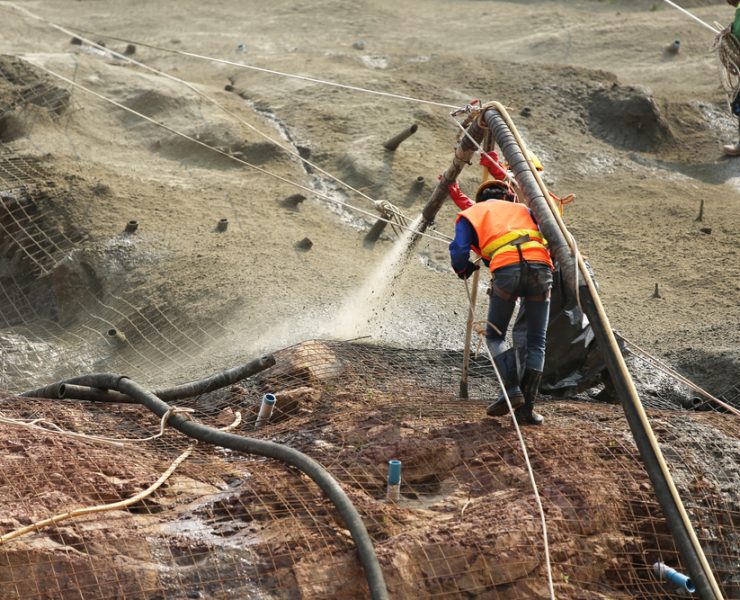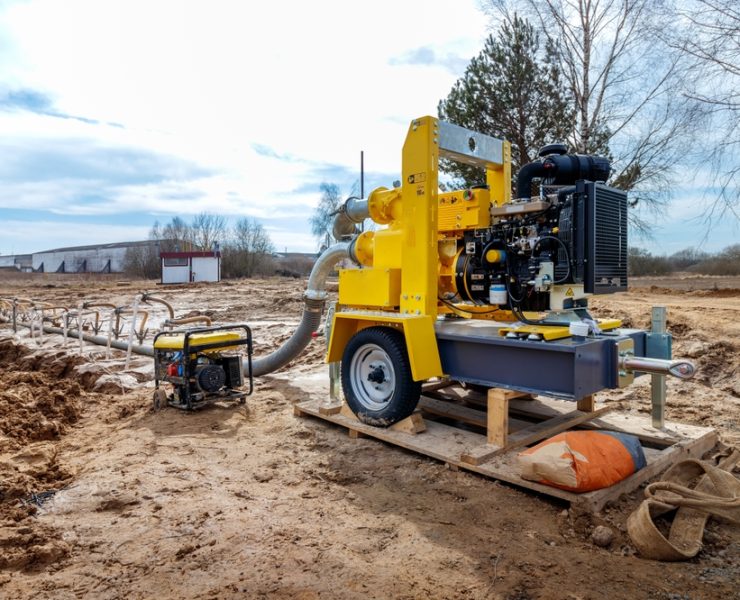Pile Driving Part II: Pile Types and Guidelines
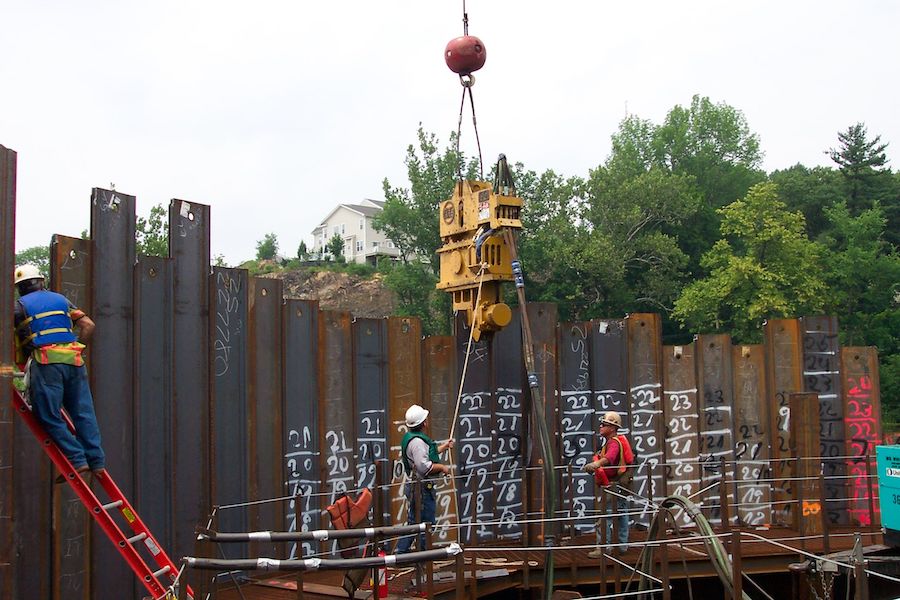

When driving piles for a construction project, understanding the types of piles and how to use them is crucial. Generally, there are two main types of piles: load bearing piles and sheet piles. When designing a project, the decision about which type of pile to use — as well as the subtype of pile — will be based on a number of factors specific to the job.
Load Bearing Piles
Load bearing piles are classified based on the type of material, installation technique, equipment used for installation and configuration. They may also be categorized based on their method of load transfer from the pile to the soil mass: friction, toe bearing or a combination of the two. There are four primary types of load bearing piles: steel, concrete, timber and plastic. Below, we’ll discuss each type and their uses.
Steel Piles
As a manufactured product, steel piles have controlled properties that are well known prior to installation. Steel piles have the highest allowable working stresses among all piling materials, but they do not necessarily have the highest in proportion to the ultimate strength of the material itself. Generally, steel piles are high capacity piles but can be used for a wide range of loadings. There are two main types of steel piles: H-piles and pipe piles.
Steel H-Piles
Steel H-piles are designed with wide flange shapes of equal thickness in both he web and flanges. The depth of each section is roughly equal to the width. These H-piles are hot rolled from ingots using the same type of mill that is used to manufacture wide flange structural shapes.
H-piles are incredibly versatile, and can be used for both end bearing and friction applications. They are purchased as a finished product that can be driven with standard equipment. There are many advantages to using H-piles, including a high individual load capacity when driven to bear on or in hard or dense materials, ready availability, compact shape with low displacement, high bending strength for applications involving lateral loads, and good tension piles for uplift. However, there are drawbacks to using H-piles, such as relatively higher cost, inability to inspections physical condition after driving, non-constant radius of gyration, and corrosion problems in certain environments if unprotected.
H-piles function most efficiently for end-bearing or partial end-bearing applications, and can be considered for a design load of between 80 and 500 kips. They are the standard for many states in certain types of construction, including highway bridge piers and abutments in remote sites. They are also commonly used for high unit dead and live loads that are associated with multi-story buildings. Given the magnitude of these loads, high capacity piles that are driven to end-bearing conditions are usually required. This is done to reduce settlements, as well as for space and economy reasons.
H-piles are useful in tension, as the constant cross-section that is entrapped in soil between the flanges offers excellent residence to pullout. In addition, H-piles can be used as battered tension piles to anchor sheet pile bulkheads. Steel H-piles can work both as compression and tension piles when uplift due to hydrostatic or wind conditions is a consideration in foundation design. The low displacement characteristic make H-piles preferable over displacement piles if ground heave may be an issue. Because H-piles can resist hard driving, they are able to penetrate soils where other types of piles cannot.
Steel H-piles are produced according to ASTM specifications, and can be produced with improved corrosion performance for salt water splash zones. This grade may be referred to as “weathering” type steel.
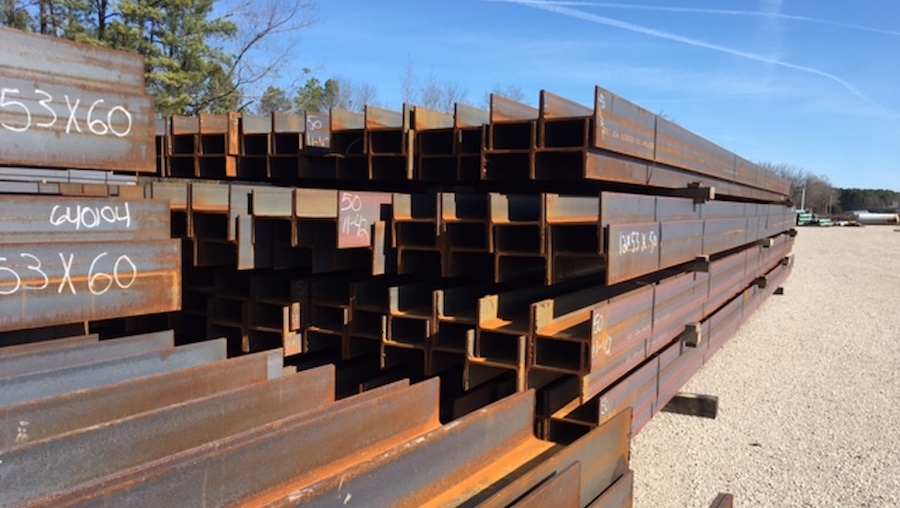
For steel piles driven in natural soil, corrosion is not often a problem due to the absence of oxygen in the soil. However, above the water table or in fill ground, moderate corrosion may occur. Protective measures such as coatings applied before driving can then be applied. This may include coal-tar epoxies, fusion bonded epoxies, Phenolic mastics and metallized aluminum mastics. In addition, cast-in-place or precast concrete can be used to encase the piles, providing protection for piles extending above the ground.
Splices in H-piles can be made by full penetration butt welds, with the splice being as strong as the pile itself. To quickly splice H-piles, proprietary splicers can be used. Because splicing is relatively easy, H-piles can be used for any depth.
H-piles may need toe reinforcement when being driven through dense soil or soil that contains boulders or rock. It may also be used for penetration into a sloping rock surface. Pile points that are welded to pile toes are often used for this application. A steel load transfer cap is not necessary if the head of the pile has been sufficiently embedded in a concrete cap.
H-piles are suitable for use as end bearing piles, as well as combinations of fiction and end bearing. Because they generally displace a minimal amount of material, they are driven more easily through staff clays and dense granular layers. The use of H-piles can reduce problems associated with soil heave and ground vibrations during the installation of a foundation. They can also be used for driving into soils that have obstructions, such as boulders, if they are properly protected at the toe.
As end-bearing piles, H-piles are most efficient when they are driven to either refusal or practical refusal on rock or into dense materials that overlay rock. The pile works as a short column, so the rock may be stronger for the steel for the maximum design load that can be applied. Competent rock in its natural bed can resist very high stress concentrations without crushing, unless the pile is installed through extremely soft soils. As a result, this combination offers the potential for high and very efficient pile loadings. When the strength of the supporting material is considerably less than the steel, the H-piles obtain support by the development of an increased bulb of pressure around the toe and friction along the embedded length.
H-piles are generally most efficient when driven through relatively deep, soft to medium stiff clays to end bearing. Piles that are installed to end bearing are often permitted much higher loads than friction piles under building codes.
As friction piles, H-piles tend to drive further in loose sands and silty sand. When H-piles are driven into stiff clays, the soil is usually trapped between the flange and the web, and becomes compacted. In this application, the soil becomes part of the pile and is carried down with it. This core of compacted soil can help to compress the surrounding soil, allowing it to build resistance to further displacement. The main load transfer is through frictional forces, rather than from end bearing. Because it can be difficult to predict the capacity of any given length that has been pile driven into stiff clays, load testing is advisable. In soft or medium clays or silts, piles will develop shaft friction resistance that is almost equal to the surface area of the pile multiple by the shear strength. Because these soils have a relatively high moisture content, pile resistance to driving will seem relatively low. As a result, it may take several weeks to determine an accurate measure of the pile’s long-term geotechnical capacity.
H-piles may also be used as soldier beams for permanent or temporary retaining walls. Typically, these H-piles are driven on 6 to 8 foot centers in a row, with the flanges facing each other. The concrete or timber lagging is then stacked with the ends of the flanges facing the webs so that the flanges of the H-piles retain the lagging. For additional lateral support, cross bracing or tieback systems can be used.
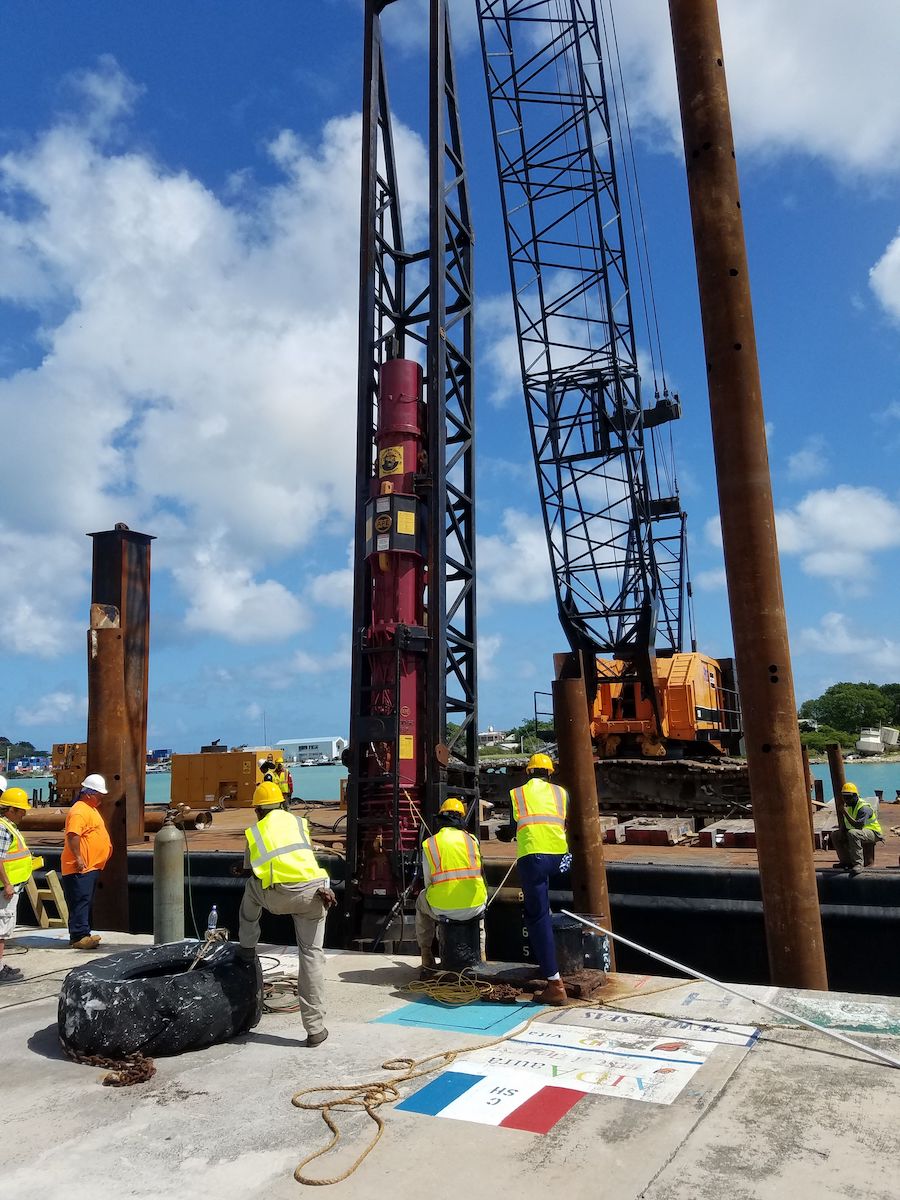
Steel Pipe Piles
Pipe piles are usually made of seamless, welded, or spiral welded steel pipes that vary in wall thickness and diameter. Larger sizes can also be used for special situations. The most common sizes of pipe piles can be used for loads between 60 to over 400 kips, and are very competitive as combination end-bearing and friction piles when driven closed-end and filled with concrete. Pipe piles also provide strong casing for concrete fill in sites where underground pressures are high. These piles can be driven with a closed or open end.
There are many advantages to using a pipe pile, including a wide selection of sizes and thicknesses, excellent delivery options, ability to drive standard sizes with conventional driving equipment, ability to resist very high individual loads when filled with concrete, ability to take advantage of composite pile when filled with concrete, ability to inspect for material damage and curvature prior to acceptance, and ease of splicing to extend lengths, resist hard driving and drive straighter. However, there are disadvantages to pipe piles. This includes resistance to penetration due to the plug of soil inside of the pipe for open-ended pipes, working as full displacement piles when closed-end pipes are used, and cost compared to other displacement piles.
Seamless pipe is made in one piece from a hot steel billet by piercing the center and expanding the steel to the desired shape and size. It is rarely specified for pipe piles due to its costs, but comes onto the market as surplus pipe. For electric weld pipe — the most commonly used pipe for piles — a variety of manufacturing processes can be used, including electric resistance welding, fusion welding and flash welding. The seams of these pipes may be spiral-butt, straight or spiral-lap. The process of making these pipes begins with hot rolled sheets or plates of steel. Depending on the production equipment, the pipe is assembled and the seams are welded. There does not appear to be an advantage of one process over the others for purposes of pipe piles to be driven.
Closed ended pipe piles may be filled with concrete or left unfilled, or filled with a structural shape in addition to the concrete, and then socketed into bedrock. If the bearing capacity from the entire toe pile area is necessary, then the pile toe should be closed using either a plate or a conical tip. Because pipe piles are generally driven from the pile head, mandrels are usually not used for this purpose. When one end of a pipe pile is equipped with a closure device, the pile becomes a displacement pile and works well as a friction pile, especially in loose sands. If driven open or closed end, it may also work as a high capacity end-bearing pile.
Open-ended pipe piles are used when hard driving is anticipated. These pipes can be outfitted with a special driving shoe that adds thickness at the toe to reduce stresses and damage. During driving, the plugger materials should be removed to assist driving. Open-ended pipe piles can also be partially shocked into rock on steeply sloping bedrock, or where the fixity of the pile at the toe is required.Pipe piles that have been driven open-ended can be filled with concrete after the plug is cleaned out, backfilled with sand, or the plug is ignored.
Open-ended pipe piles are commonly used in the installation of offshore oil platforms, whether they are driven from the surface or underwater. When used in this way, the piles are primarily designed for uplift loads due to wave or wind action on the structure. Unless the pile plug that is generated during drying makes it more difficult to drive the pile, the plug is generally not removed.
When the pile or pile group will be subjected to horizontal loads and bending moments, such as vessel impact and scour on large structures, open-ended pipe piles are recommended. Pipe piles are also the most efficient columns due to open-ended gyration, and should be considered in situations where free-standing column strength is important. These piles are particularly well-suited tin seismic situations, where liquefaction and other factors have an impact on the design of deep foundations. In these applications, the pile size may be as large as 3,000 millimeters in diameter, and may require adding on to pipe piles.
Corrosion of Steel Piles
For all types of steel piles, corrosion must be considered. In particularly, if there is seawater at the splash line, corrosion may be particularly problematic. Fresh water typically corrodes steel slowly, unless pollutants are present.
Cathodic protection may be helpful, but may not be effective in the splash zone if the steel is not always wet. On these sites, concrete jacketing may be preferable.
Paint may also provide protection if the right material is selected, the steel is properly cleaned, and the paint is applied when the steel is dry and warm. Metallized aluminum coatings can also be helpful in protecting steel piping in seawater. These coatings can be applied commercially in speciality plants.
Cast steel is naturally resistant to rust, so cast steel toe protection for steel pipes rarely rusts to any degree. Because metal only corrodes when oxygen is present, points of driven piles are usually well-protected in the ground, and protective coating are usually unnecessary.
Concrete Piles
With concrete piles, the concrete itself is the primary structural material for compressive loads. Because concrete does not work well to resist tensile load, if a concrete pile will be subjected to direct tension or bending, steel must be added to resist these stresses.
Concrete piles may be either pre-cast or cast-in-place, based on the method of manufacture. Pre-cast piles are formed in a casting bed, and then cured before being driven into place. They may be manufactured with conventional steel bars, high tensile rods or wires, or with high strength rods or wires strung through the ducts. Cast-in-place piles are cast in a pre-formed excavation at the concrete site. As a result, the concrete is not subjected to driving forces.
Cast-In-Place Concrete Piles
While cast-in-place concrete piles are typically installed by placing concrete in an excavated hole in the ground, the hole may also be lined with a steel shell or casing which can be temporary or permanent. When filled with concrete, steel pipe piles may be classified as a cast-in-place concrete pile. Pre-determining pile lengths is not as important for this type of pile, as the required pile lengths can be easily changed during installation.
This type of pile can be installed with our without a mandrel, depending on the wall thickness of the pile. A mandrel can allow piles with relatively thin walls to be driven, while those driven without a mandrel typically have thicker walls. For the latter, concrete is placed in the driven shell, and is the main basis for the structural strength of the piles. Contractors who use this method can avoid the expense of mandrels, but they will pay more for the heavier steel shell.
The most commonly used type of mandrel driver pile is the Raymond Step-Taper pile. This pile is assembled from short lengths of corrugated steel shells. At the site, the combined shell lengths are pulled up over a tapered mandrel, which is then stepped to match the shell. As the head of the mandrel is driven, both the mandrel and shell are driven into the ground. The mandrel can then be withdrawn, and the shell can be then filled with concrete. In this application, the steel acts as a form for the concrete and is not assumed to carry any portion of the applied load. Other types of mandrel driven piles are also available, which may be less economical than the Step-Taper because the tapering shape allows the use of less concrete and potentially shorter lengths to develop the same load-bearing capacity.
Monotube piles are rigid enough to be head driven by the use of heavy gauge steel that is ribbed longitudinally during a cold forming process. Monotubes are similar to lighter wall pipe piles as well as mandrel-driven cast-in-place piles in terms of friction and end-bearing applications. These piles are designed assuming both the concrete and the steel will support the applied load.
Compacted concrete piles may also be used. In this method, a heavy removable pipe shell and a charge of special mix concrete are used, with a heavy drop hammer ramming the dry-mix concrete into the soil within the pipe. As the mix descends, it pulls the pipe with it. Once the desired elevation has been reached, the pipe is restrained and the concrete mix is pounded out of the base, where it forms a compact bulb. From there, the pile shell is rammed in on the head of the bulb. This pile is best suited for granular soils.
Composite piles that combine two types of piles in a single length may consist of different materials, such as a light metal shell filled with cast-in-place concrete and a timber pile. This type of pile provides the economy of timber below the ground water table along with the durability of the concrete above. Another composite pile is a shell pile head with a pipe pile bottom, while allows for the length and penetrating ability of the pipe with the low cost of a cast-in-place concrete head. Prestressed concrete piles that are combined with a H-pile stinger may also provide toe protection and penetration assistance for the pile.
Precast and Prestressed Concrete Piles
Precast and prestressed concrete piles can be manufactured in a number of different ways. They are often cast with a hollow core in order to reduce weight, with the head and the toe of the pile cast solid. The hollow core can be used to place instrumentation doing construction or to determine pile damage. Precast concrete piles usually have a constant cross-section, but may have a tapered tip. While concrete piles are non-corrosive, they may be damaged by certain types of chemicals, electrolytic action or oxidation. Special coatings can be applied or special cements may be used to protect from chemical attack.
Precast piles must be proportioned, cast, cured, reinforced and handles in order to resist the stress included by both handling and driving, as well as structural loads. For this reason, design details should indicate the appropriate points of pickup and support for each length of pile.
Reinforced concrete piles are manufactured from concrete and have a steel rebar cage placed for reinforcement. These piles are more susceptible to damage during handling and damage, compared to prestressed pile. For this reason, they are rarely used in the United States.
Prestressed concrete piles are made in a way that is similar to a reinforced concrete pile, except that the prestressed steel replaces the longitudinal reinforcing steel. This may be in the form of strands or wires which are placed in tension. This steel is then enclosed in a conventional steel spiral. These piles can be made lighter and longer than typically reinforced concrete piles of the same rigidity.
Prestressed concrete piles may either be pre or post-tensioned. Pretensioned piles are most often cast full length in permanent casting beds, while post-tensioned piles are typically manufactured in sections and then assembled and prestressed to the required pile lengths either at the manufacturing plant or on the job site.The main advantage of prestressed concrete piles as opposed to conventional reinforced piles is that they are more durable. Because the concrete is under continuous compression, hairline cracks are kept tightly closed. In addition, the tensile stresses that can develop under certain driving conditions, are less critical. Prestressed piles are best suited for friction piles in sand, clays, and gravel.
Prestressed cylinder piles are post-tensioned piles that are spun cast in sections, then bonded with a plastic joint compound before being post-tensioned in lengths. AA special concrete is used in a process that achieves high density in low porosity. As a result, this type of pile is virtually impervious to moisture and highly resistant to chloride intrusion. This type of pile is most often used for marine structures or dry land trestles.
Pretensioned spun concrete piles is a relatively new type of pile that consists of a cylindrical pile with a void. It is similar to cylinder piles, with a different manufacturing process.
Timber Piles
Timber piles have been used in North American since the mid 1750s, and are still used to this day. While manufactured materials have made significant inroads, timber piles are still critical to foundation designs. Over 90% of timber piles used today are made of Southern Pine and Douglas fir, with some speciality timber imported from tropical areas for marine piling applications due to resistance to decay and attack by marine borer organisms. Sawed timber piles are rarely used, with the preferred shape being round and tapered.
Timber piles have a number of advantages, including low cost per ton of capacity, a renewable supply available in a range of lengths and sizes, easily handled and driven, tapered shape and full displacement characteristics for developing soil capacity in shorter lengths, and strength in tension and bending applications. However, timber piles cannot be spliced to extend lengths, are more vulnerable to driving damage, are vulnerable to deterioration unless treated, and have restive properties regarding strength, sizes and lengths.
Timber piles may processed as clean-peeled, with all outer bark and 80% of inner bark removed, rough peeled, with all outer bark removed, or unpeeled. If a pile will be further treated with preservatives, it must be clean-peeled. In many cases, timber piles are installed unpeeled and untreated, typically for use in temporary structures or a short-service life. However, most timber piles are now treated with chemicals in order to extend their lives.
Timber that is used for piling should be a sound wood, and should be free from both decay and insect damage. An inspection should be conducted to check for other potential issues, such as a separation fo the wood extending across the growth rings (a check), a circumferential separation of the rings of growth (a shake), a lengthwise separation of the wood across the growth rings (a split), knots, and straightness.
Timber piles that are continually wet due to their location below the ground water table may have an indefinite service life. However, if timber piles are subjected to a fluctuating water table or attack by insects, fungi or marine wood borers may show amid deterioration. In these situations, treatment with a preservative may be necessary. This includes the injection of creosote to preserve wood. The decision to use treated wood should be made after considering the environment in which the pile will be driven. For example, piles that are driven into fluctuating water tables should be treated entirely with preservatives including creosote, creosote-tar solution, creosote-petroleum, pentachlorophenol, ammoniacal copper arsenate, and chromatid copper arsenate to prevent moisture from reaching the wood to inhibit decay and to provide an inhospitable environment for wood-destroying organisms. Timber piles used on land in fresh water may require different preservative treatments.
Timber piles are used extensively in salt and brackish water for marine construction. However, wood borers, including mollusks and crustaceans, feed on and live in untreated wood. In warmer waters, some treatments, like creosote, may not be effective. A dual treatment of water-borne metallic salts with creosote can help to protect timber piles in salt or brackish waters.
Speciality woods can also be used for waterfront construction that function both as piles and part of the structure itself, including timber piers and docs, jetties, dolphins, and fenders. One such speciality wood is Greenheart, which is grown in Guyana, South America. This wood is particularly dense and up to 3 times stronger than Douglas fir and Southern pine in bending and compression. It also has an alkaloid substance that deters marine organisms from attacking. Its density is an additional deterrent to borers. Given the cost and supply limitations of this wood, it is not typically used for pure foundation piles.
Plastic Piles
While there are methods to protect both concrete and wood piling from decay and degradation, there are limits to how well they can be protected. To address these issues, especially in marine fender and dock piling systems, round recycled plastic piles may be used. These piles are manufactured from recycled plastic in diameters of 8 inches to 23 feet, in lengths of up to 120 feet. These plastic piles have a reinforcing cage made of steel, fiberglass, or a combination of the two. A pipe place in the center of the plastic pile can also serve as a reinforcement. Some versions of plastic piles may also have a square cross section. Plastic piles are designed to withstand both axial and lateral loads, including ship impact, and can be installed with any type of impact hammer.
Selecting a Pile Type
There are a number of factors that must be considered when choosing a pile type, based on specific project conditions and requirements. For example, for loose cohesion less soil, a tapered pile will develop maximum skin friction. For deep soft clay, rough concrete piles will increase adhesion and rate of pore water dissipation.
Other factors to consider include vibration damage from driven piles, restrictions on driving equipment size due to the remoteness of the job site, availability of certain materials, the use of shorter pile sections in waterborne operations due to pile handling limitations, and steep terrain that makes the use of certain pile equipment either costly or impossible.
In many situations, the use of several different types of piles may be possible. In these cases, the final choice should be based on cost analysis that includes the overall cost of all options. This includes uncertainties in execution, load testing program costs, the delays, and cost differences in other elements of the structure, such as pile caps.
Sheet Piles
Sheet piles are structural units that form a continuous wall when connected to one another. They are generally used for either retaining earth or excluding water. Interlocking devices that are formed during manufacturing provide continuity of the wall. There are a number of different materials that may be used for sheet piling, as discussed below. Steel is the most common choice, given its availability, relative strength, and ease of storage, handling, and installation.
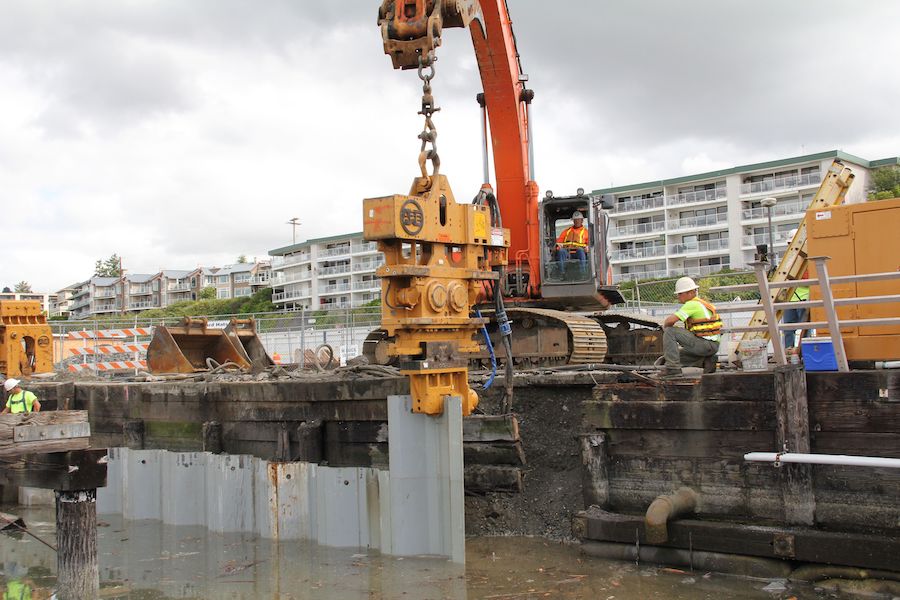
Steel Sheet Piling
Steel sheet piling is typically delivered to a job site in preordered lengths and stacked, ready for use. Individual pieces of piling or pairs that are pre-interlocked are then installed through driving with impact hammers, water jetting, or vibrators. The sheets are threaded to each other during setting and driving so that a continuous wall is formed. This wall is relatively soil and watertight.
In this capacity, the sheet piling acts as a beam under load. As such, it must resist bending. In some applications, the ability to resist bending is not as critical as the strength of the interlock.
Modern steel sheet piling consists of a range of high strength “Z,” “U” and “straight” shapes. A successful sheet piling must have both the strength and shape to withstand impact driving and must contain free-sliding interlocks to allow one sheet to be continuously connected to its neighbor. It must also be durable enough to provide the desired life and have the structural capacity to resist the anticipated loads.
Steel sheet piling can be used in a range of applications. This may include artificial islands, cofferdams, bulkheads, cut-off walls, dry dock walls, retaining walls, barge docks, mooring and turning cells, navigation lock walls, seawalls, flood walls, and bridge protection cells.
Z-type steel sheeting piling is the strongest and most efficient type of steel sheet piles. These piles resemble wide-flange beams with a web and two flanges. The interlocks are located on the flanges at the greatest distance from the neutral axis. This provides a modulus for resisting bending movements. For this reason, Z-shapes are most often used for heavier construction projects. However, they can be used with U-shapes for lighter work. Lighter weight Z-shapes may also be used for this purpose.
The interlocks on Z-type sheet piles are designed to allow both free sliding and integrity during driving. Most Z-piles are used to construct straight walls. For this reason, there is not usually a need for a guaranteed swing or deflection between sheets. Depending on the country of manufacturer, Z-shape sheet piling may have a different type of interlocking mechanism, including ball and socket, single jaw, double jaw, thumb and finger, double hook, and hook and grip. Even if the interlocks appear to be the same, contractors should not assume that sheets can be mixed while on the job. The interlocks of heavier sheet piles may not interlock with lighter piles.
Because Z-piles have a high level of inherent strength, they can typically be handled and shipped with less risk of damage compared to other sheet types. However, the interlocks of Z-types are not appropriate for splicing.
Sheet piling can be pulled after temporary use, with the interlocks cleaned and reconditioned. For this reason, there is a possibility of renting sheet piling for temporary use.
Arch web and u-shape piling are less commonly used than Z-types because they are not as efficient. This is due to the fact that the interlocks are located on the centerline of the wall, which reduces the strength of the wall to the properties of a single sheet. Other than very shallow arch shapes used mostly for circular cells, hot-rolled arch web sheet piling is not produced in the United States, but may be available from European and Japanese manufactures. Although they are less efficient than Z-piling, they are easier to work with in the field due to looser interlocks. Arch web and u-type sheets may also be easier to splice to extend lengths. Arch web shaped piles are primarily used for lighter construction, such as trench shoring, light bulkheads, shallow retaining walls and cut-off walls.
Flat and shallow arch web sheet piling are used for circular, freestanding structures known as filled cells. When used in these applications, the sheets are subject to hoop tension from internal pressure from the retained soil. As a result, the interlocks are specially designed to bear these loads. When used to build these barrel-live structures, the individual sheets resemble barrel staves. Flat and shallow arch web type piling have flat profiles so that they do not elongate and flatten across the arch.
The flat sheets are threaded using thumb and finger interlocks to continuously connect with each other around a circular guide template. The barrel of the cell is then filled with materials such as sand or rock. These filled cells are typically built on rock, hard clay, or driven into sand or gravel. While hey may be used as artificial islands, dolphins, or mooring structures, their primary application is for cofferdams construction and in bulkheads, piers or other waterfront construction. When the water is deep and the loads are high, individual cells are built and connected to each other with intermediate connector cells, resulting in a continuous wall of steel and fill. These cofferdams can be dismantled, with the piling reused, although manufacturer warranties typically extend to the first use only.
Anchor Systems
The support for a sheet pile wall is provided by an anchor system at the top of the wall. In this way, the reaction is transferred from the wall to the anchors through structural steel wales that are usually fastened to the rear of the wall by bolting. Wales are usually placed on the inside face of the wall, and consist of two channels, back to back, with spacers.
Tie rods that are spaced at regular intervals extend from the face wall through the wales to an anchor wall or anchor piles in the rear. The spacing of these tie roads is generally an even multiple of the driving distance of a pair of sheet piles. This simplifies installation. The tie rods are made from steel bars, with the ends upset to offer additional metal at the threads, and then assembled on the job with holding plates, nuts, washers, and turnbuckles. They should be located as close to the low water elevation as possible to reduce the span between supports, but installed above the water to ease installation. Tie roads should be both coated and wrapped to protect from corrosion and over stressing due to ground settlement.
Earth anchor systems and H-pile tension piles may also be used to anchor bulkheads. When there is not enough space behind a wall to install a conventional tie rod system, earth anchors may be used. They use a slant drilling technique to install high strength steel rods or cable between the wall and the rock or stable soil at a lower elevation. The anchor is then grouted in place. Steel H-piles can be driven on a batter and then fasten to the wale system. These piles then work as tension piles.
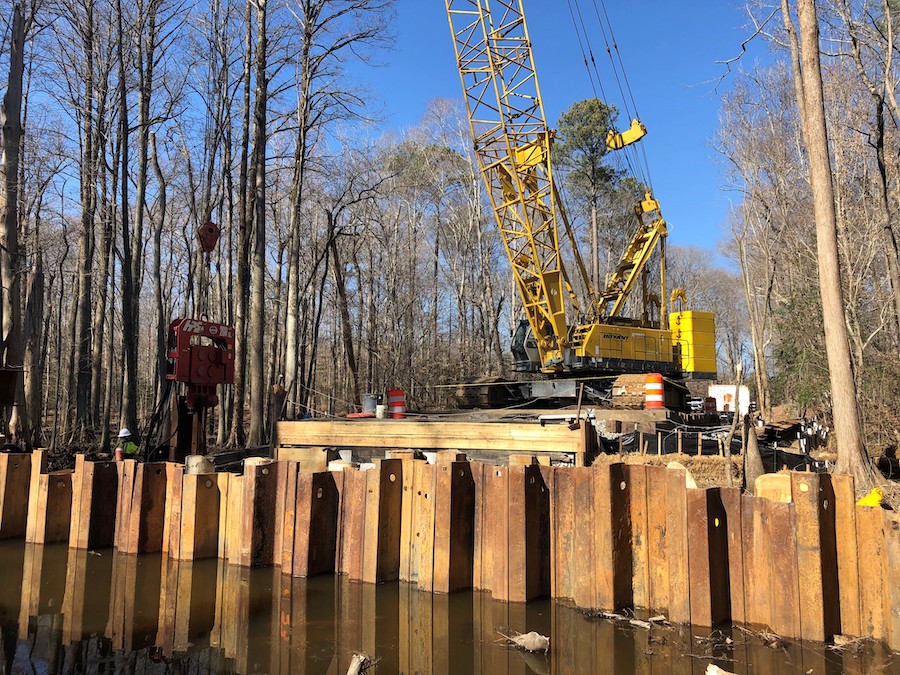
Temporary Cofferdams
To keep water out of a construction site while the permanent structure is built in the dry, stock sheet piling is almost always used. Straight wall cofferdams can be used for this purpose, consisting of a closed square or rectangular wall of sheet piling. On water, conventional bracing systems are used to keep the inside of the cofferdams clear. On land, earth or rock anchors can be used.
Reactions from the sheeting provide loads on the wales, which act as beams on supports. The loads on wales should include end thrust from other members in the tier. Cross tiers should be designed as columns and located in a way that they do not seriously interfere with the work that is happening inside of the cofferdam.
Aluminum Sheet Piling
Aluminum sheet piling can be used in both salt and fresh water applications, and is produced in various sizes, shapes and thicknesses. There are a number of considerations that should be addressed when deciding to use aluminum sheet piling, including whether it is strong enough, if it is functional, the initial and total costs over its life, if it will look good, and how long it will last.
One advantage of aluminum sheet piling over other types of sheet piling is that it is light weight, with one of the most efficient strength to weight ratios of any type of building material. Given its light weight, it is easy to handle these sheet piles. It also allows installers to work in relatively tight spots. Historically, the vast majority (90%) of aluminum piling applications have been in saltwater environments, without protective coatings. If the material is properly installed, then protective coatings will typically not be required.
One of the biggest questions to be asked about the use of aluminum sheet piling is whether it will work in a particular environment. Aluminum alloys can resist corrosion by atmospheric weathering , fresh and salt water, and performs well when in contact with a variety of soils. Its corrosion resistance is due to the protective, invisible oxide film on its surface. Even if this film is disrupted, it begins to re-form immediately when oxygen is present. As long as this oxide film is intact and continuous or can reform, the aluminum metal will maintain its high resistance to corrosion. In some conditions, however, this film may breakdown or dissolve. This typically occurs in an extremely adverse environmental condition, leading to etching and/or pitting.
To determine whether aluminum sheet piling will perform well on a job site, soil samples can be taken along the intended bulkhead installation line, as well as water samples at various points. If the test results show that either the soil or the water are outside of the safe range for aluminum, then protected aluminum, non-protected aluminum or another material may be used.
Vinyl Sheet Piling
A relatively new type of sheet piling, vinyl piles is lightweight, simple to set and stall, and resistant to environmental attack. It can be used in a range of applications and configured in various colors. Vinyl sheet piling is designed to be weather-able, corrosion resistant, unaffected by fungi and marine borers, environmentally friendly, easy to install, and cost effective. It is ideal for lighter bulkheads that are typically seen in residential, recreational, and marina construction.
Vinyl sheet piling is available in a number of configurations, the most common of which is a Z-type piling that is similar to steel piling. Because it is extruded, vinyl sheet piling can have a wider variety of sections than rolled steel sheeting. Manufacturers often offer stiffening ribs and/or thickens corners.
Vinyl sheet piling is made from a modified polyvinyl chloride (PVC). This makes it appropriate for most marine environments. This vinyl also includes a UV stabilizer, which works to reduce deterioration due to sunlight. Vinyl sheet piling has low values of strength and elasticity compared to other sheet pile materials. Like any other type of plastics, material properties are more difficult to apply than with metals. Tensile strength can vary considerably based on the way that the sheeting is loaded and with time. For this reason, the manufacturer’s recommendations on loading should be followed closely.
This type of piling can be installed using a vibratory hammer, portable air-compressor or a hydraulic jackhammer with a sheet shoe, a drop impact hammer, or a water jet fuel by a high output pump. As with other types of sheet piling, vinyl sheet piling should be set before being driven. It may be possible to set this piling by hand given its light weight, or with a crane or excavator. The exact installation method will depend on job site conditions and contractor preference.
Pultruded Fiberglass Sheeting
Pultruded fiberglass sheeting is a relatively new product that consists of a high performance resin with significant longitudinal and tensile strength. Because it is pulled through the die that forms its shape, instead of being pushed through, the sheets are very consistent in tolerance and properties from one to the next.
Pultruded sheet piling is resistant to corrosion, UV degradation, and attacks of marine borers and other destructive elements. These sheets are also lightweight, which allows for easier installation in most cases.
Pultruded fiberglass sheet pile walls are designed using the same principles as other types of sheet piling materials. However, it is more susceptible to deflection than steel sheeting, so care should be taken to ensure that excessive deflections do not occur. It may be more susceptible to local buckling and transverse bending, which may be avoided by limiting conventional bending and deflection stresses. The interlock strength of this material may not be sufficient for some applications, such as cofferdams, because the transverse strength is less than the longitudinal strength. Backfill should be carefully chosen to avoid rupturing the sheets during expansion due to changes in water content, with weep holes drilled into the sheeting to allow for drainage. Pultruded sheet piling should not be placed against rock.
Pultruded sheeting piles are installed in a similar way to other types of sheet piling, as described above. It is best set before being driven. When safety conditions permit, this may be done by hand. Otherwise, it can be installed with a crane or an excavator. After the sheeting is driven, the wales, tiebacks, and caps should be installed.
Wood Sheeting
Wood sheet piling can be used for smaller excavations when there is not a significant problem with ground water. It may consist of a single ling or boards or single-sheet piling. In saturated soils, a more elaborate form of wood sheet piling must be used, such as overlapping boards spiked or bolted together. For example, the Wakefield system consists of three planks of specified thickness and width, bottled and/or spiked together with the center piece one or more inches ahead of the others to form a tongue and groove.
Concrete Sheet Piles
Concrete sheet piles are a cost-effective choice for sea walls, groins, and other waterfront structures. They are often used when the precast members will be incorporated into the final structure or will remain in place after construction. If the piles are precast, they typically consist of a tongue and groove section, reinforced with vertical bars and hoops.
If the piles will be in contact with seawater, prestressing as critical to close the minor cracks. While this type of sheeting is not watertight, the spaces between the piles can be grouted. A tongue and groove design will help to make a concrete sheet pile wall waterproof. After the pile is installed, the slots are washed out and grout forced into the opening.
When designing a project that includes either bearing or sheet piles, it is vital to understand the various types of piles available as well as their appropriate uses. While there may be more than one type of pile that can be used in a particular job, there is often a more economical choice based on both immediate and long-term costs. By throughly researching each alternative, the best selection can be made for both present and future durability.
What are Load Bearing Piles?
Load bearing piles are classified based on the type of material, installation technique, equipment used for installation and configuration. They may also be categorized based on their method of load transfer from the pile to the soil mass: friction, toe bearing or a combination of the two. There are four primary types of load bearing piles: steel, concrete, timber and plastic. Below, we’ll discuss each type and their uses.
How many kinds of steel piles are there?
Generally, steel piles are high capacity piles but can be used for a wide range of loadings. There are two main types of steel piles: H-piles and pipe piles.















